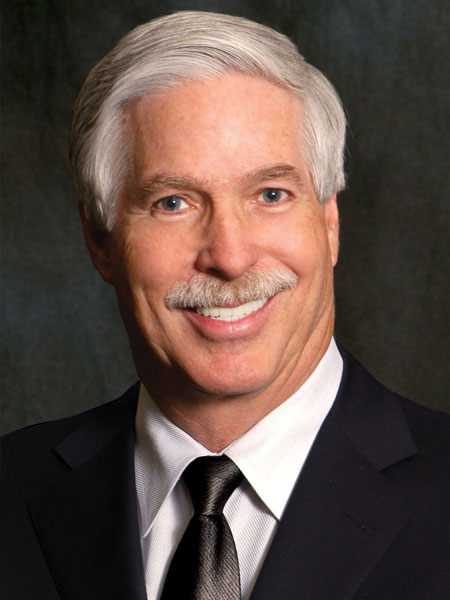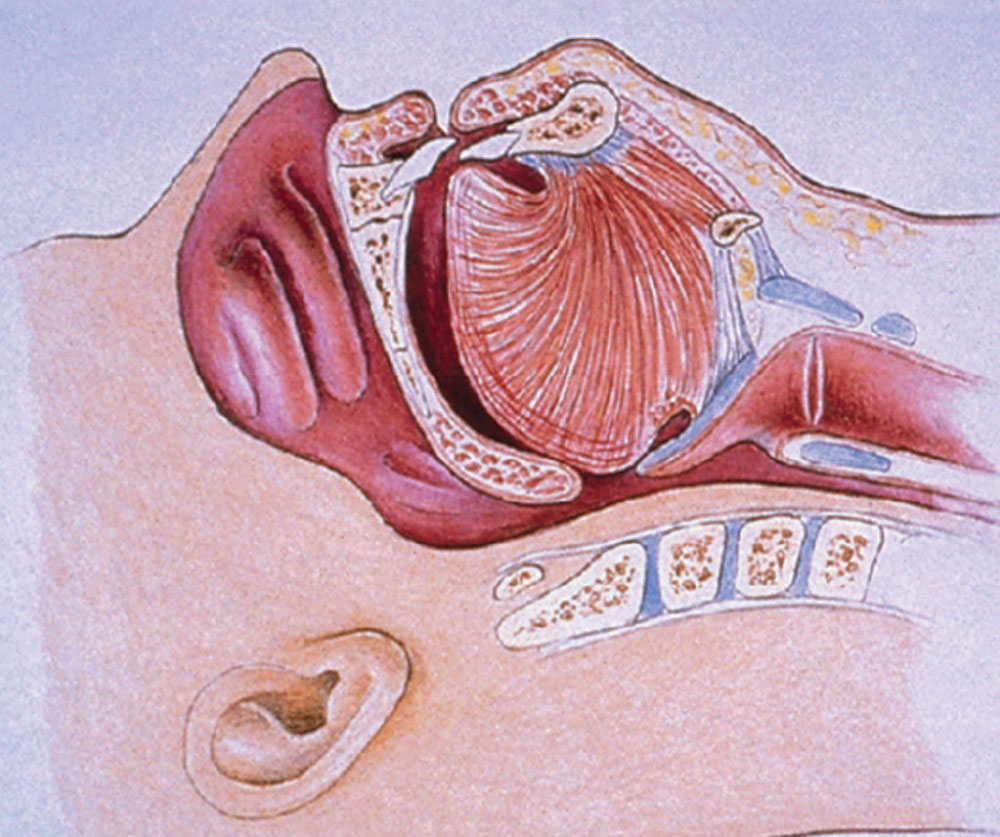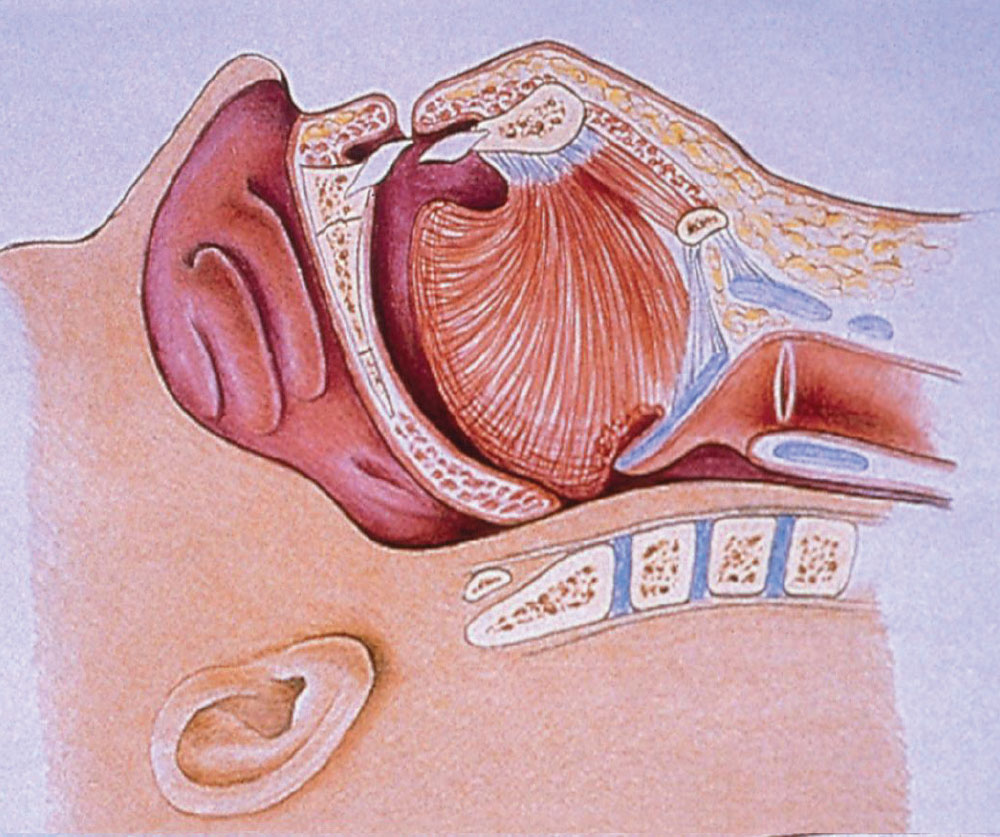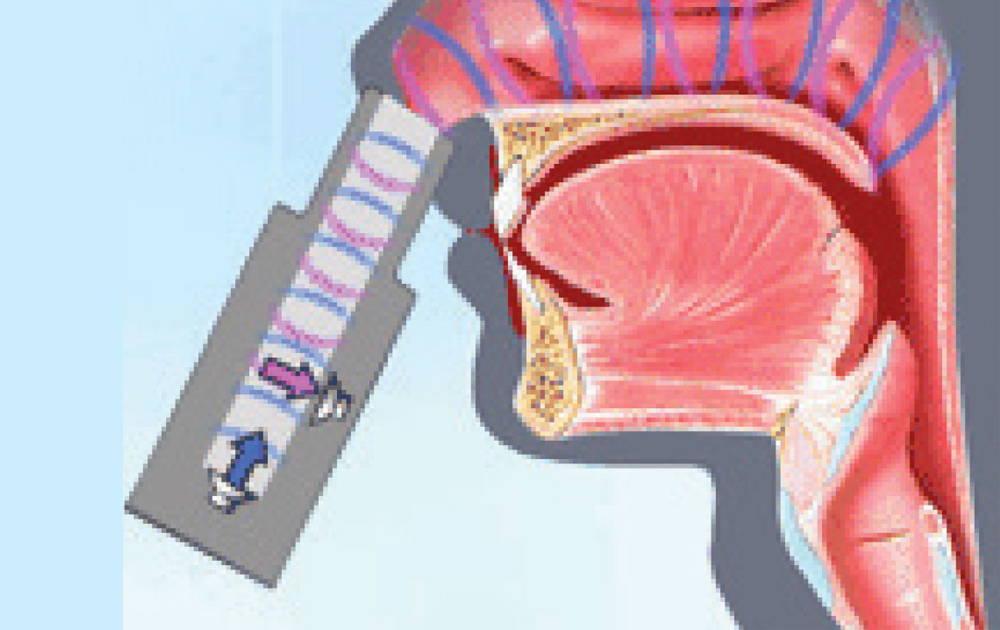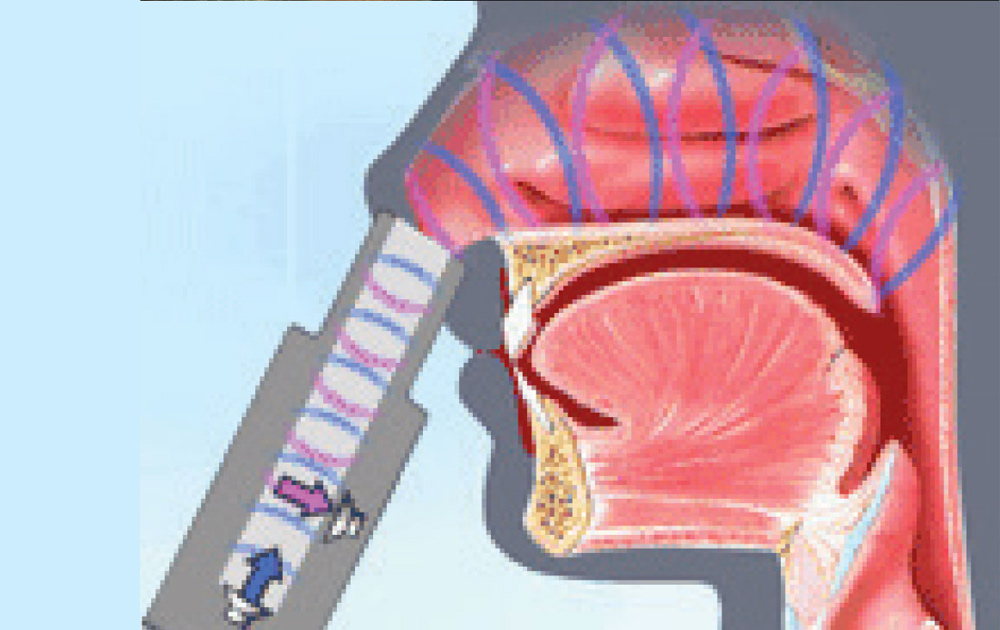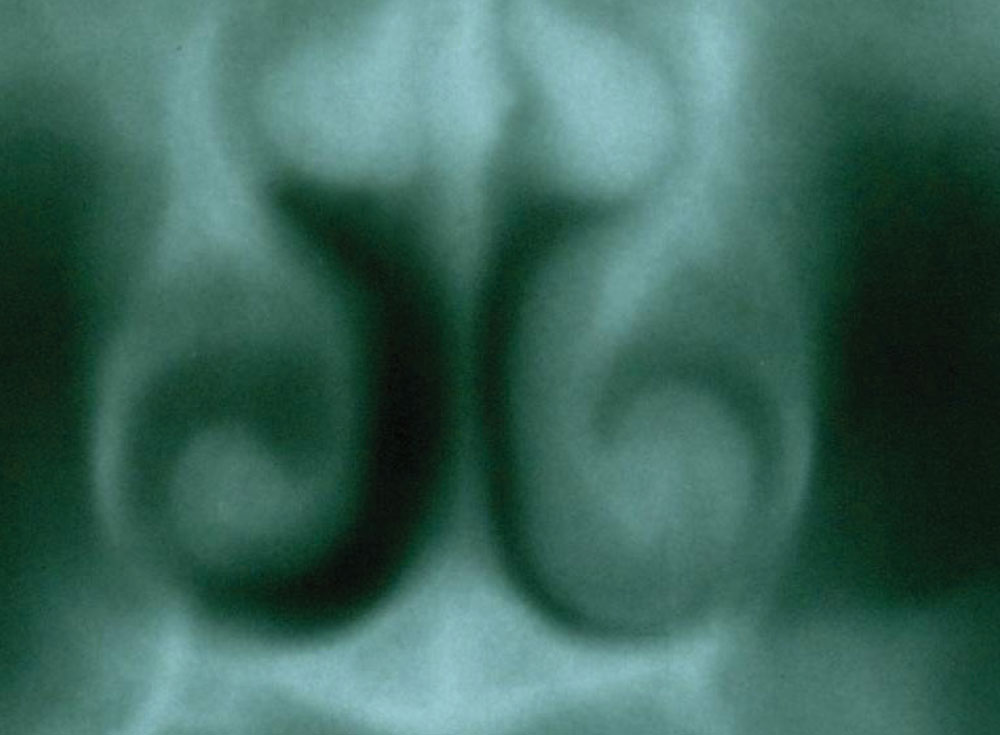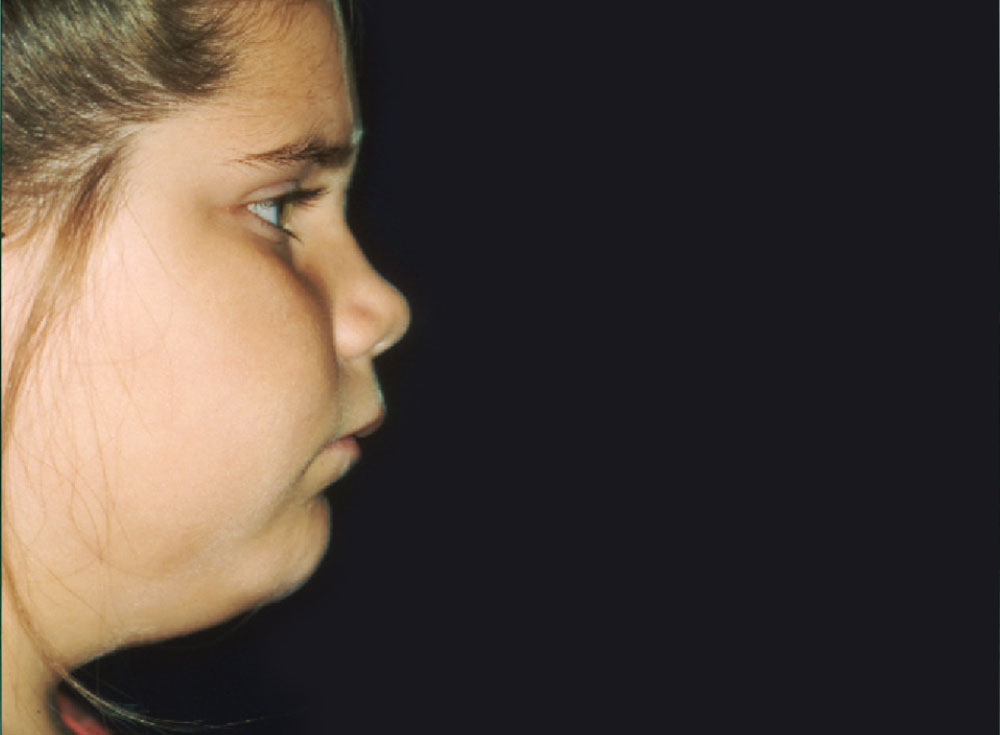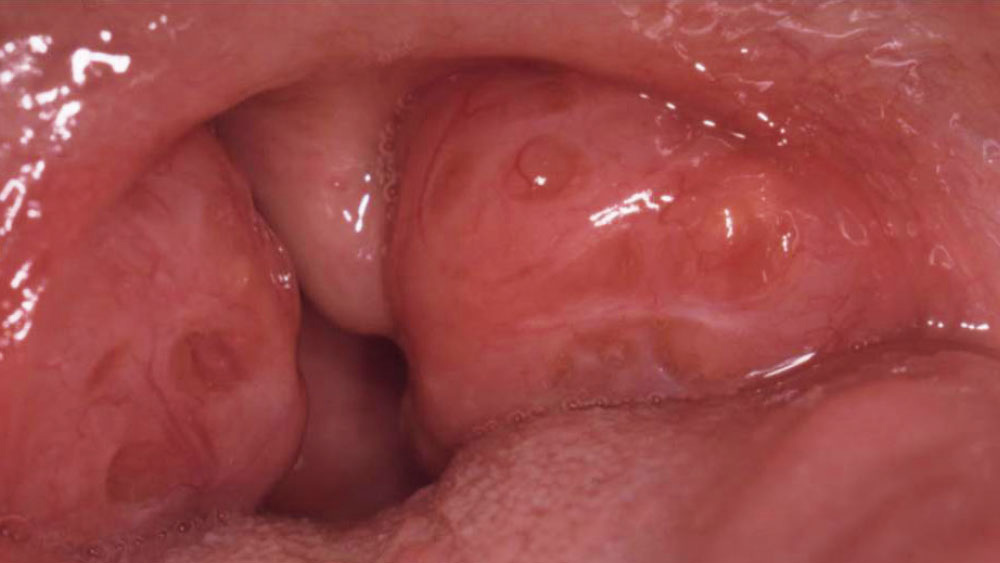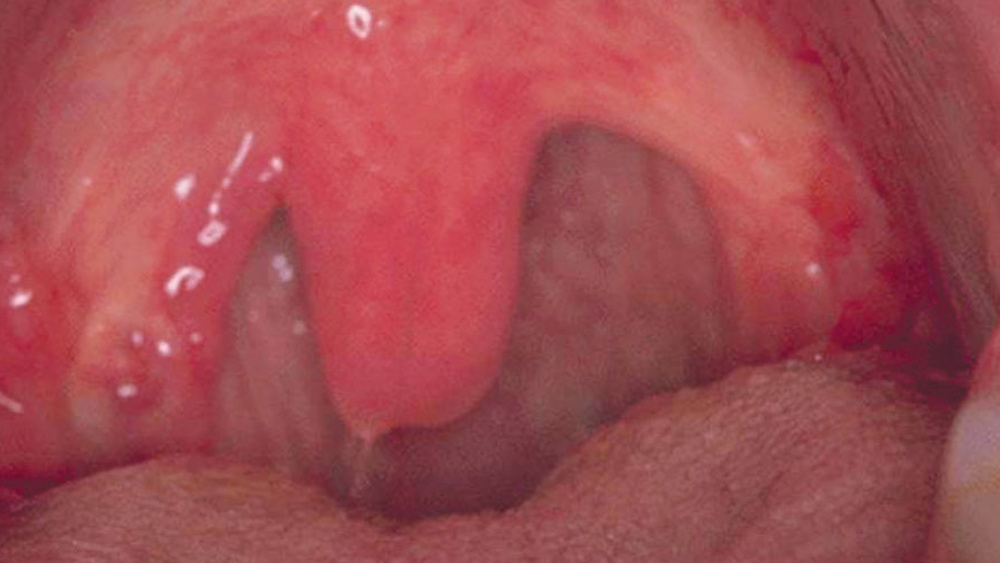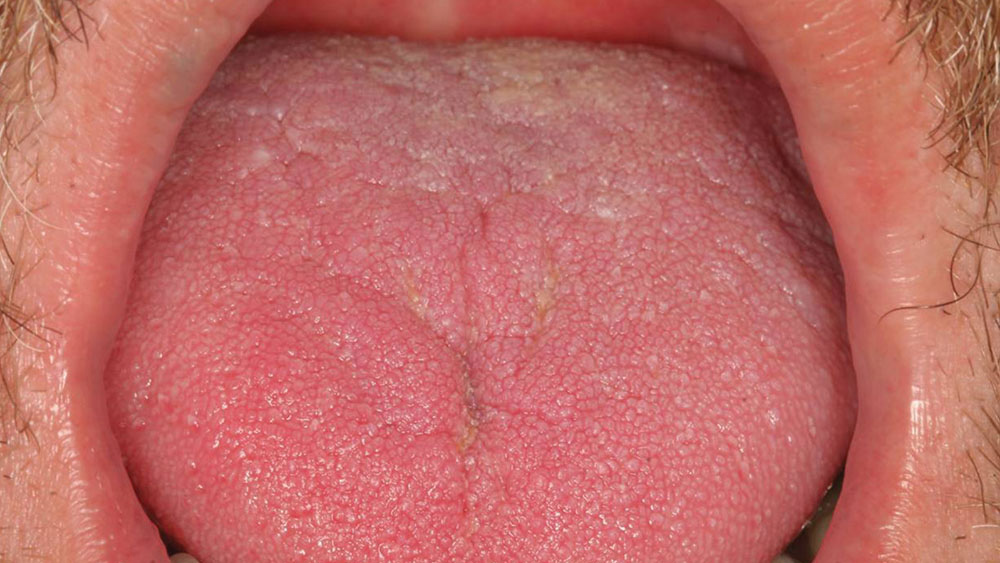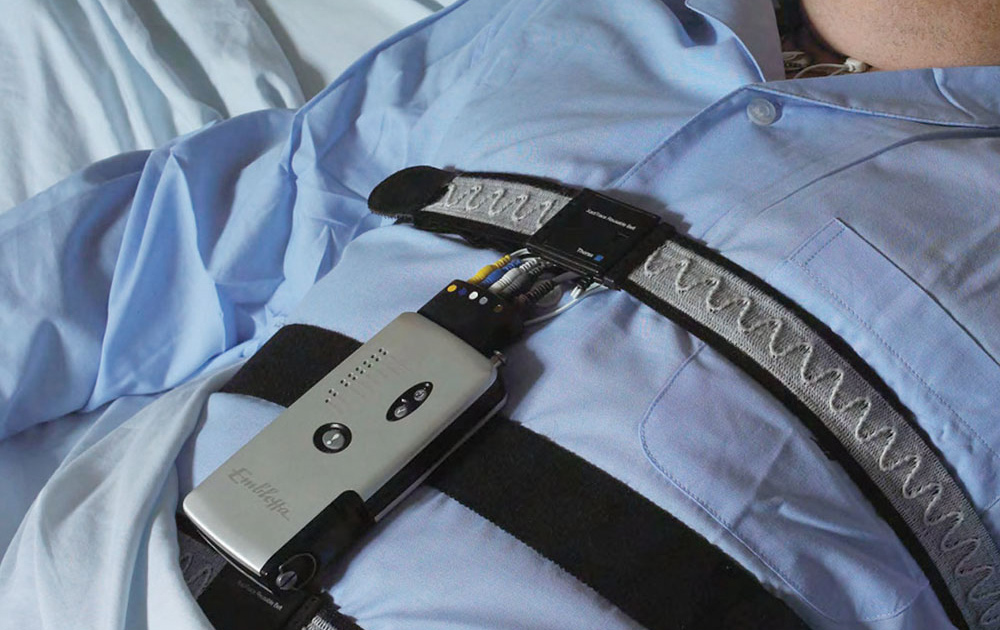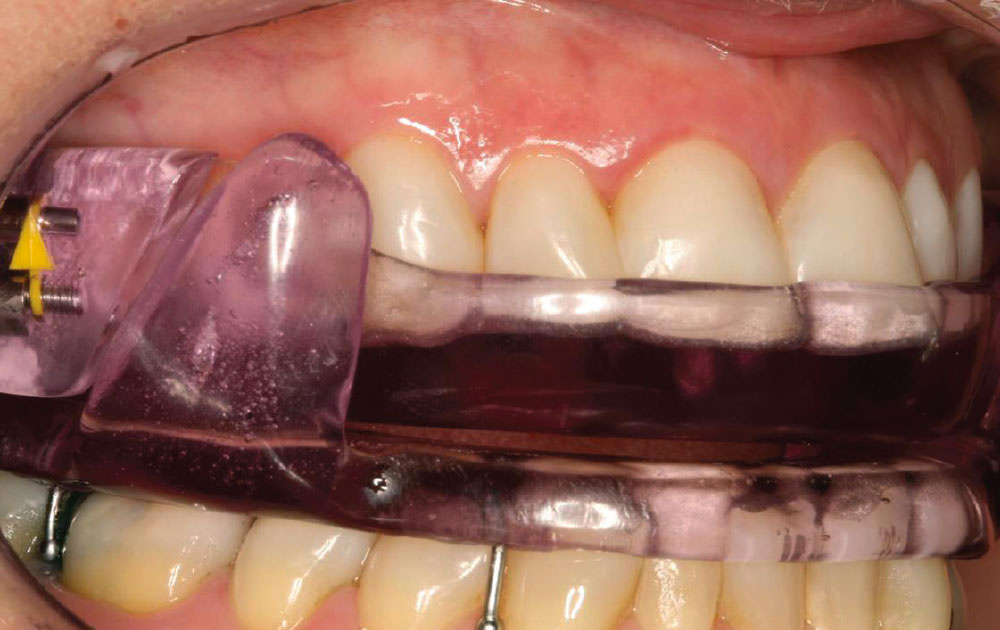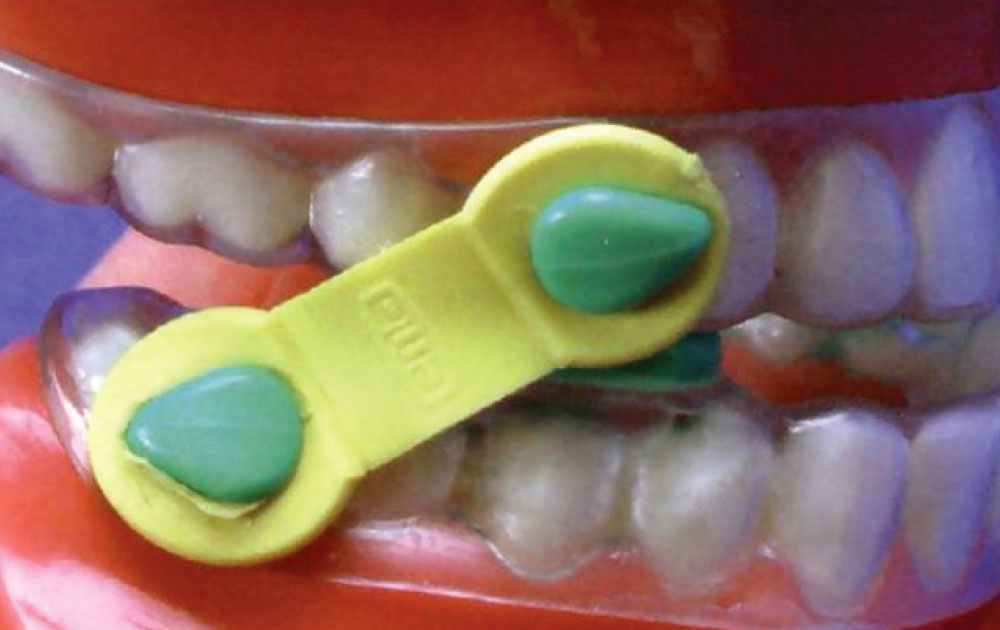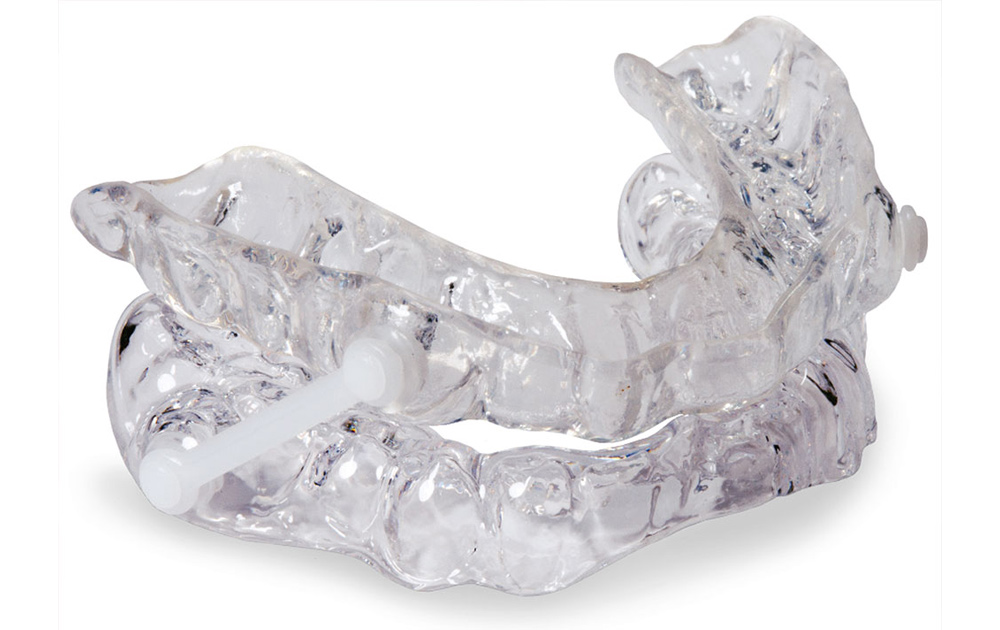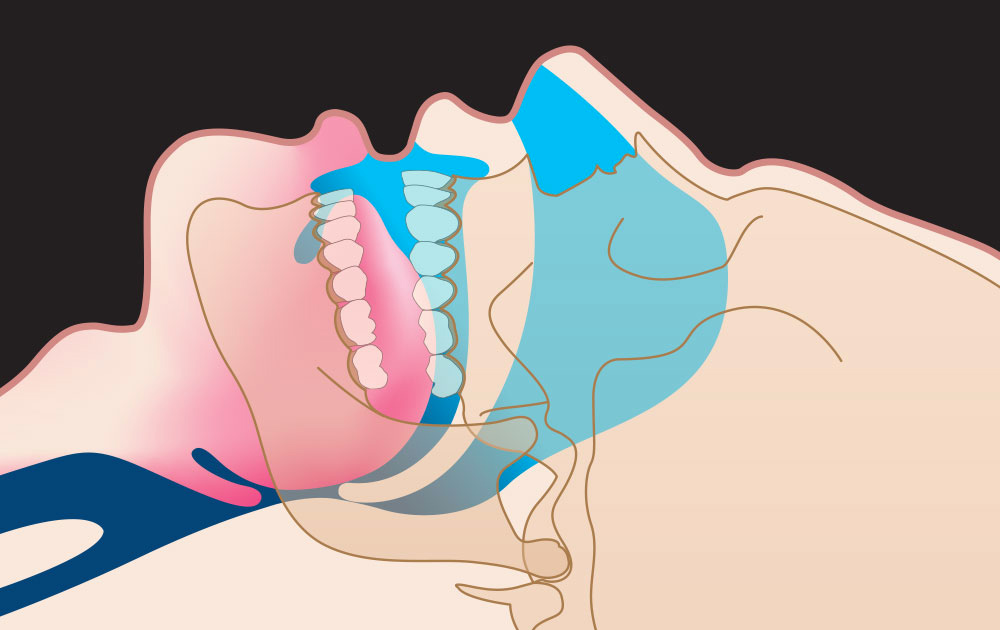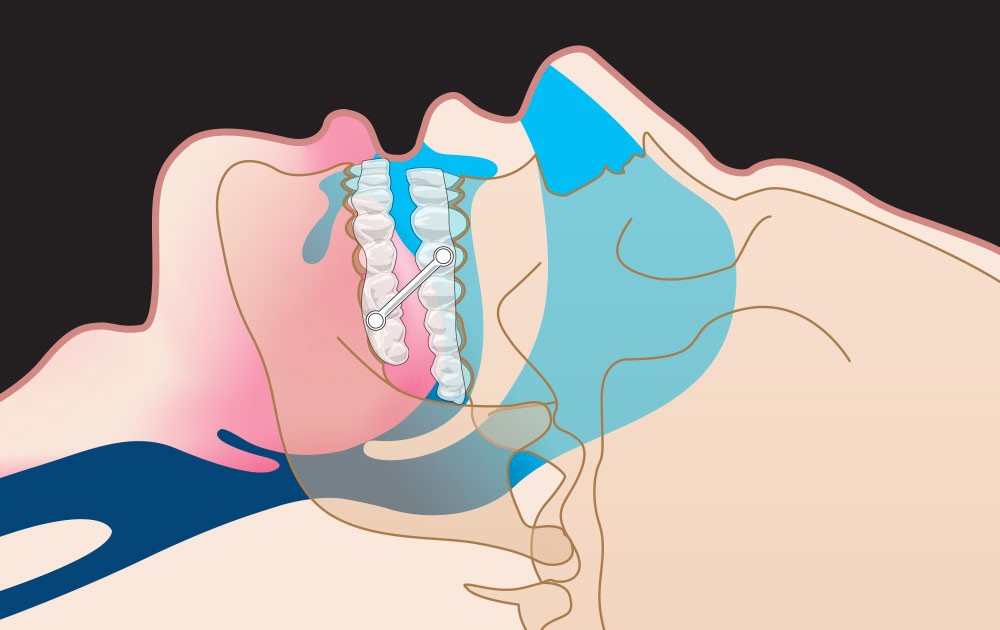The Dentist’s Involvement in Snoring and Sleep Apnea

It has been estimated that 60 million Americans snore and at least 18 million suffer from obstructive sleep apnea (OSA). The most common signs of OSA are snoring and excessive daytime sleepiness. Because patients visit their dentists on a more regular basis than any other health care professional, we have an excellent opportunity to educate, diagnose and treat patients using oral appliances.
Snoring is defined as obstructed breathing during sleep and is caused by vibration of the pharyngeal tissue. This can be caused by various factors, including an increase in fat deposits due to obesity. Patients who drink alcohol before bedtime or take a sedative also experience more collapse of the pharyngeal airway, which increases the incidence of snoring. Snoring usually occurs on inspiration but can also occur on expiration and persists when there is a partial blockage of the airway, oftentimes caused by the tongue becoming too relaxed. If this is the cause of snoring, it can easily be corrected with an oral appliance, which works by moving the lower jaw and tongue forward to keep the airway open during sleep.
Social Problem
Snoring has a serious impact on the snorer’s bed partner and adversely affects many relationships. When the bed partner is deprived of quality sleep, this can result in separate bedrooms and, in some cases, can even lead to divorce. The combination of extreme daytime fatigue coupled with snoring can cause marital discord and sexual dysfunction, including decreased libido and impotence.1 Studies report that when the bed partner’s sleep is affected by as much as one hour per night, it can have a negative effect on the bed partner’s health.
USA Today reported that 27% of couples over age 40 sleep in separate bedrooms, which further demonstrates a direct correlation between this and the incidence of snoring. As the incidence of obesity continues to increase in our society, these numbers will continue to increase.
Health Risks of Snoring
Snoring typically has been regarded as a social problem with minimal adverse health affects. However, a study of 110 patients in Sydney, Australia, found that heavy snoring significantly increases the risk of carotid atherosclerosis; the risk factor was independent of OSA. It appears that the vibrations on the pharyngeal walls are transmitted to the walls of the carotid artery.2 Ultrasound was used to measure the amount of plaque in the carotid arteries. The conclusion was that prevalence of carotid atherosclerosis was 20% with mild snoring, 32% with moderate snoring and 64% with heavy snoring. Therefore, patients must be made aware of this danger, so they can find a solution before increased atherosclerosis in the carotid arteries causes greater cardiovascular complications.
Terms Associated with Sleep Disordered Breathing
Apnea: Cessation of breath for 10 seconds or longer
Hypopnea: Cessation of breath for less than 10 seconds; blood oxygen level decreases 4% or more
Mild Sleep Apnea (OSA): 5–15 events per hour
Moderate Sleep Apnea (OSA): 16–30 events per hour
Severe Sleep Apnea (OSA): More than 30 events per hour
Apnea is defined as a cessation of breath for 10 seconds or longer. Hypopnea is an episode of shallow breathing with a 50% reduction in airflow and a decrease in blood oxygen level of 4% or more. Sleep apnea occurs when the tongue completely blocks the airway repeatedly throughout the night. It is this repetitive collapse or blockage of the pharyngeal airway that causes OSA. Signs of OSA include daytime sleepiness, loud snoring, witnessed breathing interruptions, or awakening due to gasping or choking.
Oxygen saturation is an extremely important measurement of patient health. Decreased blood oxygen levels adversely affect patient health by increasing blood pressure, which can lead to cardiovascular complications, including cardiac arrhythmias, heart attack and stroke.
Diagnosis of Obstructive Sleep Apnea
Sleep apnea is a medical disorder that can only be diagnosed by a sleep specialist. The patient must have an overnight sleep study called a polysomnogram, or PSG, which is evaluated by the sleep specialist. Many sleep specialists prefer to prescribe the CPAP (continuous positive airway pressure) device to treat OSA and do not appreciate the effective role oral appliances play for patients who have mild or moderate OSA, or patients who cannot tolerate the CPAP device.
OSA is the most common sleep-related breathing disorder and is widely recognized as a public health issue.3 It is more prevalent than asthma and in the U.S. is as common as diabetes.4
OSA has been misdiagnosed for many years, being mistaken for depression, chronic fatigue syndrome or, in children, attention deficit hyperactivity disorder. These disorders can result from lack of adequate oxygen in the blood, which is common in patients with OSA. Patients with OSA fall asleep during the day — in meetings, at work, and while driving and watching TV — due to inadequate sleep. Other side effects include gastroesophageal reflux disease (GERD), migraine headaches and metabolic syndrome. Can you imagine waking up 20 to 50 times per hour, every hour, all night long? It’s no wonder patients with OSA suffer from chronic fatigue and sleepiness.
Three Treatment Options for Obstructive Sleep Apnea
- Oral appliances
- CPAP device (continuous positive air pressure)
- Surgical removal of structures causing the obstruction
Once the patient has completed the sleep study and the Apnea-Hypopnea Index (AHI) has been determined, each treatment option must be explained. Clinicians should distinguish between mild, moderate and severe OSA. Patients who are diagnosed with severe OSA should be encouraged by the dentist and sleep specialist to wear the CPAP device — this is considered the gold standard for the treatment of severe OSA. The CPAP delivers oxygen to the patient through a mask that fits over the nose, or over the nose and mouth, via an air compressor and humidifier. The CPAP is effective in opening the airway, as the air pressure is gradually increased during the follow-up sleep study. The air pressure successfully displaces the tongue, uvula and soft palate and allows an adequate amount of oxygen to enter the lungs.
When the patient wears the CPAP and the air pressure is correct, it is extremely effective in eliminating OSA. Patients who are happy with their CPAP devices should not be encouraged to replace them with oral appliance therapy. Oral appliances should mainly be used for patients who cannot tolerate the CPAP device or who have mild to moderate OSA.
The majority of patients in my office are either encouraged to seek a solution for their snoring problem or were diagnosed with OSA and are unable to wear the CPAP. Statistics on the success of the CPAP device vary depending on what articles you read, but the consensus is approximately 60% to 70% of patients are not wearing it after one year. This means there is tremendous opportunity for dentists to treat snoring and OSA with oral appliances.
Patients will sometimes ask about oral appliances they see advertised on the internet. Most of these are boil-and-bite appliances and put the jaw in only one position. They cannot be adjusted and often are ineffective. There is a second problem with these “internet devices”; one such device, called PureSleep® (The Pure Sleep Company; Larkspur, Calif.), clearly states that it is not designed to treat patients with TMJ dysfunction or sleep apnea. The company is correct. No one can legally treat sleep apnea unless a medical professional, usually a sleep specialist, has made a diagnosis. Therefore, the majority of patients do not qualify for these internet devices. A third major problem with these devices is there is no follow-up sleep study to determine the efficacy of the appliance in treating OSA.
Once patients are properly educated, they are no longer interested in appliances that will not resolve their OSA. Patients who have tried internet appliances admit they are not as comfortable as custom oral appliances.
Only medical practitioners such as sleep specialists or ENT specialists can diagnose OSA. Dentists have a solution for treating this medical disorder, but we must learn to work with our medical colleagues to make the system work for the benefit of patients. OSA is an extremely prevalent disorder with some serious health consequences.
Co-Morbidity Correlations with Obstructive Sleep Apnea
Hypertension 40% – 50%
Coronary heart disease 34%
Congestive heart failure 34%
Diabetes 65%
Erectile dysfunction 50%
Renal disease 50%
Fibromyalgia 80%
Nocturnal strokes 84%
There is also a high correlation between patients who have GERD5 and OSA. With regard to diabetes, excessive apneic events affect the production of insulin, which encourages the onset of type 2 diabetes.6 Apneic events also affect the permeability of the endothelial lining of the arteries. This increases the buildup of plaque in the arteries and the chance of cardiovascular complications, such as heart attack. The weakening of the walls of the arteries increases the susceptibility of rupturing of these vessels, which occurs during strokes.7
To assist practitioners in the diagnosis of OSA, we need to focus on airway obstruction in three areas: nasal, oropharyngeal and hypopharyngeal.
1. Nasal Obstruction
Prior to treatment, dentists must determine whether there are any nasal obstructions that would interfere with the patient’s ability to breathe through his or her nose. If the patient is a chronic mouth-breather, the patient should be referred to an ENT specialist to check for a deviated septum, enlarged turbinates, polyps or other nasal obstructions. A determination must be made whether the nasal mucosa is swollen due to allergies, which might cause a nasal obstruction.8
In our office, we have a diagnostic device known as a rhinometer,9 which is an initial screening device to determine if there is a nasal obstruction in either nostril. The rhinometer is an accurate, noninvasive device that evaluates the potential obstruction by sending sound waves up the nose and recording any obstructions on a computer.10
Evaluation of the nasal cavity is also important should the sleep specialist decide to use the CPAP device to force air through the nose. Obviously, if there is a nasal obstruction the pressure would have to be much higher on the CPAP device. The acceptance of CPAP treatment is better when the pressure is lower. Therefore, an evaluation of a patient’s nasal airway is an important prerequisite to successful oral appliance or CPAP therapy.9
The X-rays above are paranasal sinus tomogram X-rays of the nasal cavity. The pretreatment X-ray shows enlarged turbinates severely obstructing the airway (black area). The patient had an AHI 76, which indicates severe OSA.
The post-treatment X-ray shows the naval cavity after nasal surgery involving a resection of the inferior turbinates. Clearly, the size of the airway (black area) has significantly increased. There was a 50% improvement in the patient’s sleep apnea. This patient would likely be offered an oral appliance to move the tongue forward to open up the airway, which may further reduce AHI and improve the patient’s health.
2. Oropharyngeal Obstructions
Prior to the fabrication of an oral appliance or CPAP therapy, an evaluation must be done of the oral cavity to check for obstructions. The areas of concern would be enlarged tonsils or adenoids, large tongue, enlarged uvula, large mandibular tori, excess tissue in the area of the soft palate or an enlarged torus palatinus. Patients with narrow maxillary arches and high palates are also more susceptible to snoring and OSA. Oropharyngeal obstructions must be surgically corrected prior to oral appliance or CPAP therapy.
3. Hypopharyngeal Obstructions
Oral appliances are most effective when there are no nasal or oropharyngeal obstructions and the problem is behind the tongue in the area of the throat. Class II skeletal patients with retrognathic mandibles are more likely to have hypopharyngeal obstructions. Their lower jaws are already retruded, which subsequently causes their tongues to be retruded. This is particularly serious when the patient sleeps on his or her back. The tongue falls back farther and blocks the airway. If the tongue partially blocks the airway, the patient snores. If the tongue completely blocks the airway for 10 seconds or longer, more than six times per hour, the patient is diagnosed with OSA.
The main function of the oral appliance is to move the lower jaw forward, increase the posterior vertical dimension and, subsequently, move the tongue forward and open up the pharyngeal airway.
The pharyngometer is a diagnostic device used to diagnose the size of the airway during daytime and nighttime hours.11 It is utilized at the initial appointment to check the patient’s normal airway (daytime) and the collapsed airway (nighttime).
To assess the size of the collapsed airway at night, the patient is instructed to exhale all the air from his or her lungs and a measurement of the airway is taken. The normal size of a collapsed airway is 2 cm. Patients with OSA usually have a much smaller collapsed airway. Bite registrations in different positions are taken to try to determine how large the airway may be increased.
Our office uses a system called Airway Metrics,12 which consists of a number of plastic bite jigs to help measure the size of the airway in different positions. Various bite registrations are taken, including some that may be end-to-end and open 6 mm, 1 mm protrusive and open 4 mm, and end-to-end and open 4 mm. By moving the mandible forward at different vertical heights, we determine whether the oral appliance will significantly open the airway in that position. In most cases, when a bite registration reveals the airway opens significantly and the oral appliance is fabricated in that position, treatment is usually successful.
The results using different bite registrations are not always successful if the patient has a physiologically narrow airway or excessive swelling in the area of the uvula and soft palate due to excessive snoring or smoking. The pharyngometer gives the clinician a starting position for fabrication of the oral appliance. It is important to select a position that is comfortable for the patient. I recommend oral appliances such as SomnoDent® (SomnoMed; Frisco, Texas), Myerson™ EMA®, modified Herbst® (SomnoMed), The SUAD™ Device (SomnoMed) or TAP®, which can be adjusted to move the mandible slowly forward to reduce snoring and OSA.13
As mentioned previously, airway obstructions in the nasal and oropharyngeal areas must be eliminated before fabrication of the oral appliance. When oral appliances are utilized in these cases, they are highly effective. Our success rate with oral appliance therapy is more than 90%. I routinely evaluate my patients’ nasal airways with a rhinometer, and their oropharyngeal and hypopharyngeal airways with a pharyngometer prior to treatment. If you cannot properly diagnose the problem, treatment will not be successful.
It is estimated that 18% to 30% of the population suffers from mild, moderate or severe OSA. With the U.S. population now at 309 million, that is a large number of patients potentially suffering from sleep disorders. These patients desperately need treatment.
Helping patients achieve a higher level of health improves dentists’ feelings about their practice and themselves. Presently in my office, we are treating approximately 10 to 15 patients per month at $3,000 per case. Treating these patients can have a positive effect on your income while increasing patients’ health. In the U.S., many medical plans will pay for both the CPAP and oral appliances, while Canadian insurance companies will pay for the CPAP device but not for oral appliances.
It is the responsibility of the medical and dental profession to identify patients who have airway obstructions that may lead to snoring and sleep apnea. The two main signs of OSA are snoring and excessive daytime sleepiness. To assist dentists in determining the level of sleepiness, Dr. Murray Johns of Epworth Hospital, Melbourne, Australia, in 1991 introduced the Epworth Sleepiness Scale (ESS). I recommend that any patient who snores complete this survey. It is also advisable to have the bed partner complete the form. Our experience has been that many patients, particularly males, underestimate the extent of their daytime sleepiness, whereas the report from the bed partner is usually more accurate.
It is the responsibility of the medical and dental profession to identify patients who have airway obstructions that may lead to snoring and sleep apnea. The two main signs of OSA are snoring and excessive daytime sleepiness.
The ESS is extremely helpful in determining the extent of daytime sleepiness, which is one of the main symptoms of OSA. This 4-point scale (0–3) determines how likely the patient is to fall asleep in eight different situations or activities most people engage in as part of their daily lives. A “0” means he or she would never doze off; “1” means a slight chance of dozing; “2” represents a moderate chance of dozing; and “3” signifies a high chance of dozing in various situations. The total ESS score is the sum of the eight item scores and can range between 0 and 24. The number of patients with daytime sleepiness, especially those over age 50, will be significant.
In one of my sleep courses, I asked a dentist (who was part of a group practice) to go back to his office and give the ESS questionnaire to all patients who snored. Remember, snoring is one of the main symptoms of OSA. Within three weeks, he had 50 patients who scored high on the ESS and who, therefore, were candidates for oral appliances or the CPAP device. It is important to educate your staff, including receptionists, dental assistants and hygienists, regarding the diagnosis and treatment of these patients; hygienists are especially important in conveying this information to the patient to ensure they complete the ESS.
Medical attention in the form of a sleep study is recommended for patients who score 8 or higher to diagnose the presence or absence of OSA.14 Patients who snore but do not have OSA may be treated by the dentist with an oral appliance. Prior to the fabrication of the oral appliance, the dentist must receive a report from a sleep specialist stating the patient does not have sleep apnea. A follow-up sleep study is not needed. If the patient is diagnosed with mild to moderate OSA and the sleep specialist and patient agree on treatment, the dentist can then fabricate an oral appliance.
After the oral appliance has been adjusted over several months, the patient is required to complete a follow-up sleep study to confirm the efficacy of the appliance. It is imperative for dentists to establish a good relationship with a sleep specialist if they desire to be successful in the field of sleep dentistry.
I advise all dentists who are interested in expanding their practice to educate themselves and their staffs in dental sleep medicine. Contact a sleep specialist to diagnose patients with a sleep study prior to treatment, and then after treatment to confirm the efficacy of the oral appliance. Most sleep specialists welcome the opportunity to work with competent dentists. Once a good relationship has been established, this will result in referrals for patients with mild sleep apnea and those who cannot tolerate the CPAP device.
Another excellent diagnostic device that has been useful in my practice is the Embletta® X100 (Embla Systems Inc.; Broomfield, Colo.), a home sleep study that patients prefer over a hospital sleep study. The Embletta X100 cannot be used to diagnose OSA unless confirmed by a sleep specialist, but it is useful during the titration or adjustment period for the oral appliance. Most oral appliances are not 100% effective when first inserted. The uvula and soft palate tissues can be quite swollen due to snoring and/or smoking. As the swelling subsides, the appliance is slowly adjusted to move the mandible and tongue farther forward, which takes two to four months.
During the titration period, I advise dentists to test the efficacy of the oral appliance with a home sleep study.15 The advantages of the home sleep study device are that it is extremely comfortable, yields accurate results and patients feel they are getting a more normal sleep because they are in their own beds. The cost is reasonable to the patient, as the price of disposables for a home sleep study is approximately $6 per study. Therefore, patients can be given several economical and convenient sleep studies to ensure the oral appliance is effective in eliminating snoring and OSA.
The Embletta X100 device is more acceptable to medical professionals and sleep specialists because it has a nasal cannula, pulse oximeter, and chest and abdominal straps. Sleep center specialists utilize it for patients who are unsuccessful with the PSG. Some patients do not like the PSG because of electrode odor, because they suffer from claustrophobia or because they cannot sleep in a strange bed with 16 electrodes attached to their body. Most patients feel they get better results when sleeping in their own bed. In Europe, most of the studies are home sleep studies due to the significant cost savings when compared with the cost of a PSG sleep study in a private or hospital sleep clinic.
The Embletta X100 home sleep study reputedly has been No. 1 in Europe for the past eight years. It has been well researched, and the results correlate very accurately with the PSG at sleep clinics.
It is extremely important to successfully titrate (adjust) the oral appliance with the Embletta X100 home sleep study device before sending the patient for a PSG at a private or hospital sleep clinic. This will prove to sleep and ENT specialists that oral appliances are effective in reducing snoring and OSA. This will result in more patient referrals from sleep specialists and ENTs for treatment with oral appliances.
The patient is instructed to return to the sleep center with the oral appliance for a follow-up PSG to confirm that the appliance is effective. Insurance companies and patients much prefer this approach. You cannot expect insurance companies to pay for three or four sleep studies. The sleep specialists are usually impressed with the results and will, therefore, be encouraged to refer more patients to your office who cannot wear the CPAP or have mild to moderate OSA.
To ensure successful treatment of our patients, it is crucial that we work closely with experts in the medical profession. Reports must be sent to the patient’s primary care physician to keep him or her informed of the patient’s treatment. Dentists should also inform sleep specialists that patients with severe OSA must be referred for treatment with the CPAP or BiPAP (bilevel positive airway pressure) devices. Patients who are diagnosed with severe OSA should be encouraged to wear the CPAP device because it is the gold standard for the treatment of severe OSA.
Once the sleep specialist diagnoses the patient, the patient will return for a second sleep study. During this second study, the technician determines what air pressure will be necessary to eliminate the patient’s OSA. The more serious the problem and, in some cases, the more obese the patient, the more substantially the pressure must be increased to obtain the desired result. Lower air pressure usually results in better compliance. The exception to this would be patients with severe sleep apnea who seem to benefit the most from the CPAP. These patients feel so exhausted prior to wearing the CPAP and feel so refreshed afterward that their compliance rate is high. My observation has been patients with mild to moderate OSA are not as compliant, and this is where the dental profession needs to become more involved. If the patient’s condition is mild to moderate and there is no necessity for surgery, the best option is a custom oral appliance. The fact is that a larger number of patients who are prescribed CPAP devices cannot tolerate them.16
Recently, Medicare started paying for treatment for patients with OSA. Medicare is willing to pay for a CPAP device, but the health insurance program wants confirmation on compliance. Insurance companies do not want to pay for the device if it is not being utilized on a regular basis. The newer devices can be integrated with a telephone line, and a third party analyzes the data to verify compliance. If there is no compliance, Medicare will not pay for the device.
There are several different CPAP and BiPAP devices, and patients should be encouraged to try several types until they find one that is acceptable. I am constantly amazed that patients diagnosed with OSA, who were prescribed a CPAP unit but could not tolerate the device, were never again contacted by either the sleep specialist or the durable medical equipment company. Some of these patients already have co-morbid factors such as high blood pressure, cardiovascular disease, type 2 diabetes and GERD, and their health continues to deteriorate. The system certainly needs to be improved for the benefit of these patients.
Dentists and staff members interested in pursuing education in sleep disorder dentistry should be encouraged to take some courses. One suggestion would be to consult my website, rondeauseminars.com, for sleep courses taught by experienced clinicians and lecturers across the U.S. Soon, many courses will also be available online.
I would also encourage interested dentists to join the American Academy of Dental Sleep Medicine. This organization offers courses that will help practitioners accumulate new and important information on sleep disorders such as OSA.
Oral Appliances
Oral appliances are extremely effective in eliminating snoring and OSA, particularly in patients with mild to moderate OSA.14 They function by moving the lower jaw and, consequently, the tongue forward to open up the airway.15 They hold the lower jaw forward when the patient sleeps on his or her back, which keeps the airway open all night. The literature is replete with articles regarding the effectiveness of different oral appliances.17 It should be stressed to the patient that oral appliances are extremely comfortable.
Three oral appliances that are utilized to prevent snoring and OSA are SomnoDent, Myerson EMA and Silent Nite® (Glidewell Laboratories; Newport Beach, Calif.). The appliances all work essentially the same way, by gradually moving the lower jaw forward in small increments and increasing the vertical dimension, which ultimately increases the size of the pharyngeal airway.
In the case of the SomnoDent appliance, the mandible is gradually and painlessly moved forward by turning the two side screws. The Myerson EMA appliance is adjusted by changing the straps on the side of the appliance. The Silent Nite appliance is adjusted by changing the arm size and arm length, which gradually and comfortably advances the mandible. When thorough examination of the nasal and oropharyngeal airway reveals no obstructions, oral appliances are extremely effective. This is because in approximately 66% of cases, the obstruction occurs at the base of the tongue.
It is imperative that dentists learn to treat patients with mild to moderate OSA and those who cannot tolerate the CPAP device.18 I have treated many patients with severe OSA who could not wear the CPAP device and successfully reduced their apneic events to below fives times per hour, which is normal. Custom oral appliance treatment improves health and prolongs life expectancy by reducing blood pressure and susceptibility to heart attack, stroke and type 2 diabetes.5
Opportunity for Dentists to Make Highways Safer for Everyone
Crashes involving commercial truck drivers are a significant health hazard, causing thousands of deaths and injuries each year, with driver fatigue and sleepiness being the major causes.
In the American Journal of Respiratory and Critical Care Medicine, it was reported in 2004 that as many as 41% of the major crashes of commercial vehicles were due to driver sleepiness. In 2001, large trucks were involved in 429,000 crashes, with nearly 5,000 fatalities.19 I am certain the incidence would be much higher today due to the current obesity epidemic.
In the American Journal of Respiratory and Critical Care Medicine, it was reported in 2004 that as many as 41% of the major crashes of commercial vehicles were due to driver sleepiness.
There is increasing awareness that drowsy drivers who suffer from OSA cause more accidents than drunk drivers. Many years ago, the laws regarding drinking and driving were not as stringent as they are today. Organizations such as Mothers Against Drunk Driving have helped convince the police and driver’s licensing agencies to send drivers to jail who are guilty of this offense. In North America, there is discussion about mandatory OSA testing for all commercial truck drivers.
There have been numerous sleep studies done on commercial drivers, with 12% to 80% of drivers being diagnosed with OSA. Obesity and age are two important factors: The older and more obese the driver, the higher incidence of OSA — in particular, severe OSA.
The hurdles in treating OSA are the issues of education and compliance. One study found 17% of commercial drivers were diagnosed with OSA. Of the 53 drivers diagnosed with OSA, only one driver complied with treatment recommendations.20 The drivers were concerned that if diagnosed with OSA they would lose their driver’s license, which is essential for their livelihood. It is important for medical and dental professionals to highlight the fact that OSA is a treatable medical disorder. These drivers, and the general population, also need to be educated on the consequences of not being treated for OSA. These consequences include:
- OSA sufferers’ health can be seriously compromised if they do not get the problem resolved. In cases of severe OSA, life expectancy is reduced by eight to 18 years.
- OSA increases the risk of high blood pressure, heart disease, stroke, type 2 diabetes and acid reflux.
- Daytime drowsiness when behind the wheel can result in injury to oneself, passengers or other drives on the road.
Dr. Philip Parks, medical director of Lifespan Health and Occupational Health Services, stated: “It is well known that obesity, a leading risk factor for obstructive sleep apnea, is on the rise in the United States. Truck drivers with sleep apnea have a seven-fold increased risk of being involved in a motor vehicle crash.”19
It has been estimated that as many as 3.9 million licensed U.S. commercial drivers have OSA. The problem is not the diagnosis but that commercial drivers are not educated or motivated to seek treatment for this serious medical condition. This isn’t surprising considering the lack of education the average medical or dental school has provided in the past. Many medical schools reported less than one hour of training in sleep-disordered breathing in four years of medical school. I am encouraged by the fact that this is changing in more recent medical school curriculums. However, most dental schools still do not teach anything in this extremely important subject.
This problem needs to be addressed immediately in order to save lives and prevent injures. The employers of truck drivers, in my opinion, should encourage every driver to complete an overnight sleep study to diagnose the absence or presence of OSA. Employers must be aware of the liability issues and the potential repercussions that could occur if a driver was to fall asleep behind the wheel of one of its trucks. Perhaps dentists involved in dental sleep medicine should approach trucking companies in the area and encourage them to educate, diagnose and treat drivers who suffer from OSA.
However, even if the government ordered every truck driver in the U.S. to be tested for OSA, there are not enough available sleep labs to perform the sleep study. Similarly, there are not enough dentists to treat the patients. Presently, there are 165,000 dentists in the U.S. and Canada; just 1,800 are members of the American Academy of Dental Sleep Medicine. Dentists who take courses now and increase their skill level in this area will be extremely busy once the government implements mandatory OSA testing for commercial drivers. Commercial airline pilots have mandatory testing now, and I predict that in the near future this will be applied to commercial truck drivers.
While the U.S. government resolves this problem, I would recommend:
- Encouraging patients who are commercial truck drivers to get a sleep study to see if they have OSA. If they do have sleep apnea, encourage them to get treated. For mild to moderate OSA, recommend oral appliances; for severe OSA, recommend CPAP as a first option.
- Encouraging patients who snore or who have a score higher than 7 on the Epworth Sleepiness Scale questionnaire to undergo a sleep study to diagnose the presence of OSA.
- If you are on the highway, particularly at night, do not drive too closely to trucks due to the high incidence of truckers with OSA, which causes significant sleepiness and more accidents.
Conclusion
The prevalence of obstructive sleep apnea is exceedingly high in developed countries due to the obesity epidemic. In the U.S. and Canada, an estimated 25% of males and 9% of females will develop OSA in their lifetime.21 It is the obligation of the dental and medical professions to learn how to diagnose and treat these patients.
There are only three ways to treat OSA: oral appliances, CPAP and surgery. While some patients may need a combination treatment, oral appliances are certainly the preferred treatment because they are noninvasive and reversible. The problem with the CPAP and BiPAP devices is that the compliance rate is only 60% after one year.16 Therefore, literally thousands of patients are seeking alternate forms of treatment. Compounding this enormous problem is that an estimated 85% of patients with OSA are undiagnosed.
The prevalence of Obstructive Sleep Apnea is exceedingly high in developed countries due to the obesity epidemic. In the U.S. and Canada, an estimated 25% of males and 9% of females will develop OSA in their lifetime.
Dentists who desire to treat this medical disorder must utilize various sleep health questionnaires, including the Epworth Sleepiness Scale. I recommend that interested dentists take courses and learn how to utilize various diagnostic devices, including the rhinometer, pharyngometer and Embletta X100. When you suspect a patient suffers from OSA, refer him or her to a primary care physician and sleep specialist for overnight sleep study in order to make a diagnosis.
For mild to moderate cases of OSA, oral appliances are the first treatment option. The compliance rate for oral appliances is extremely high in our office — more than 95%. Many patients who fail with CPAP aren’t even made aware of the existence or efficacy of custom oral appliances. It is our responsibility to educate our medical colleagues on the effectiveness of oral appliances and also to work with them to help treat OSA, which truly has become a health epidemic.
To contact Dr. Brock Rondeau, call 877-372-7625, visit rondeauseminars.com or email brondeau@rondeauseminars.com. Clinical photos provided by Sleep Group Solutions, 16840 NE 19th Ave., North Miami Beach, Flor. 33162; 866-353-3936; sleepgs.com.
References
- ^ Fanfulla F, Malaguti S, Montagna T, et al. Erectile dysfunction in men with obstructive sleep apnea: an early sign of nerve involvement. Sleep. 2000 Sep 15;23(6):775-81.
- ^ Lee SA, Amis TC, Byth K, Larcos G, Kairaitis K, Robinson TD, Wheatley JR. Heavy snoring as a cause of carotid artery atherosclerosis. Sleep. 2008 Sep;31(9):1207-13.
- ^ Lacasse Y, Godbout C, Series F. Health-related quality of life in obstructive sleep apnea. Eur Respir J. 2002 Mar;19(3):499-503.
- ^ Harris MI, Flegal KM, Cowie CC, et al. Prevalence of diabetes, impaired fasting glucose, and impaired glucose tolerance in U.S. adults: the third national health and nutrition examination survey, 1988–1994. Diabetes Care. 1998 Apr;21(4):518-24.
- ^ Somers VK, White DP, Amin R, Abraham WT, Costa F, Culebras A, Daniels S, Floras JS, Hunt CE, Olson LJ, Pickering TG, Russell R, Woo M, Young T. Sleep apnea and cardiovascular disease: an American Heart Association/American College of Cardiology Foundation scientific statement from the American Heart Association Council for High Blood Pressure Research Professional Education Committee, Council on Clinical Cardiology, Stroke Council, and Council on Cardiovascular Nursing Council. J Am Coll Cardiol. 2008;52(8):686-717.
- ^ Babu AR, Herdegen J. Fogelfeld L, et al. Type 2 diabetes, glycemic control, and continuous positive airway pressure in obstructive sleep apnea. Arch Intern Med. 2005 Feb 28;165(4):447-52.
- ^ Jean-Louis G, Zizi F, Clark LT, Brown CD, McFarlane SI. Obstructive sleep apnea and cardiovascular disease: role of the metabolic syndrome and its components. J Clin Sleep Med. 2008 Jun 15;4(3):261-72.
- ^ Young T, Finn L, Kim H. Nasal obstruction as a risk factor for sleep-disordered breathing. J Allergy Clin Immunol. 1997 Feb;99(2):S757-62.
- ^ Austin CE, Foreman JC. Acoustic rhinometry compared with posterior rhinomanometry in the measurement of histamine- and bradykinin-induced changes in nasal airway patency. Br J Clin Pharmacol. 1994 Jan;37(1):33-7.
- ^ Hilberg O, Jackson AC, Switf DL, Pedersen OF. Acoustic rhinometry: evaluation of nasal cavity geometry by acoustic reflection. J Appl Physiol. 1989 Jan;66(1):295-303.
- ^ Gelardi M, Del Giudice AM, Cariti F, Cassano M, Farras AC, Fiorella ML, Cassano P. Acoustic pharyngometry: clinical and instrumental correlations in sleep disorders. Braz de Otorhinolaryngol. 2007 Mar-Apr;73(2):257-65.
- ^ Taché D. Utilizing acoustic pharyngometry to improve efficacy of hybrid therapy in the management of an unresponsive severe CPAP-intolerant patient. The Sleep Magazine. 2010:9-14.
- ^ Cistulli PA, Gotsopoulos H, Marklund M, Lowe AA. Treatment of snoring and obstructive sleep apnea with mandibular repositioning appliances. Sleep Med Rev. 2004 Dec;8(6):443-57.
- ^ Kushida CA, Morgenthaler TI, Littner MR, Alessi CA, Bailey D, Coleman Jr J, et al. Practice parameters for the treatment of snoring and obstructive sleep apnea with oral appliances: an update for 2005. Sleep. 2006 Feb;29(2):240.
- ^ Chung F, Liao P, Sun Y, Amirshahi B, Fazel H, Shapiro CM, Elasid H. Perioperative practical experiences in using a level 2 portable polysomnography. Sleep and Breathing. March 2010;1522-1709.
- ^ Engleman HM, et al. Compliance with CPAP therapy in patients with sleep apnea/hypopnea syndrome, Respiratory Medicine Unit, City Hosp, Edinburgh EH10 5SB.
- ^ Gindre L, Gagnadoux F, et al. Mandibular advancement for obstructive sleep apnea: dose effect on apnea, long-term use and tolerance. Respiration. 2008;76(4):386-92.
- ^ Chan AS, Cistulli PA. Oral appliance treatment of obstructive sleep apnea: an update. Curr Opin Pulm Med. 2009 Nov;15(6):591-6.
- ^ Parks P, Durand G, Tsismenakis AJ, Vela-Bueno A, Kales S. Screening for obstructive sleep apnea during commercial driver medical examinations. J Occup Environ Med. 2009 Mar;51(3):275-82.
- ^ Lifespan (Mar 12, 2009). Obesity linked to dangerous sleep apnea in truck drivers. ScienceDaily, retrieved May 10, 2010, http://www.sciencedaily.com/releases/2009/03/090311111002.htm.
- ^ Young T, Evans I, Finn I, Palta M. Estimation of the clinically diagnosed proportion of sleep apnea syndrome in middle-aged men and women. Sleep. 1997;20:705-6.


